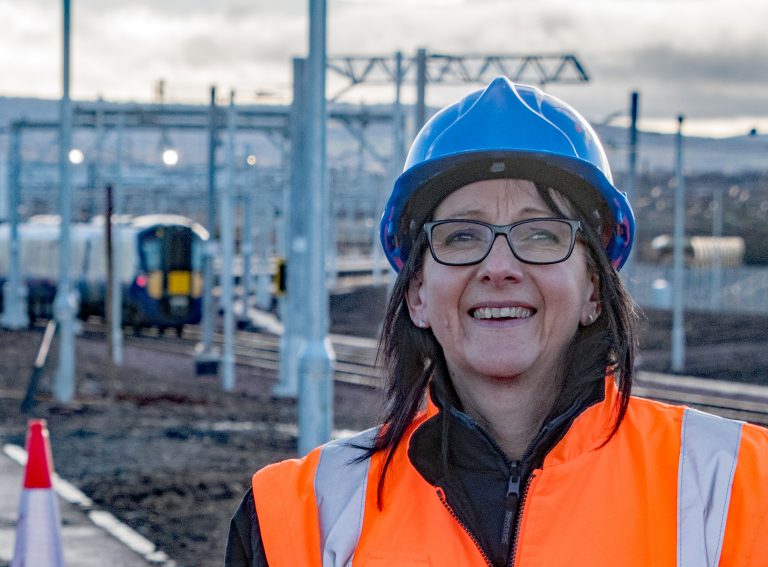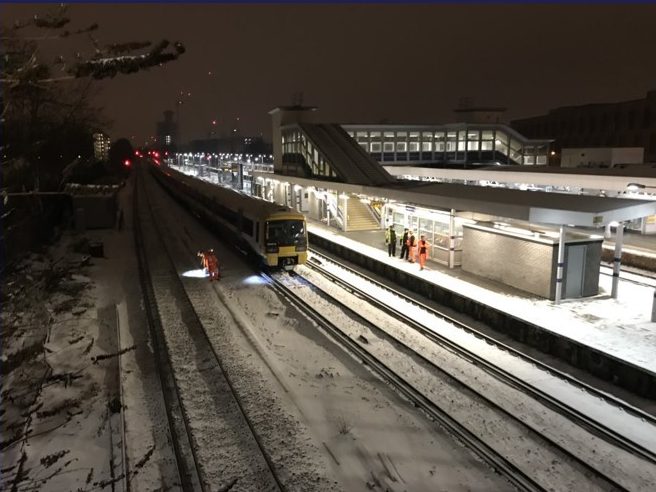When Mark Carne took over as chief executive of Network Rail more than four years ago he inherited an ambitious programme of works which he concluded could not be delivered as planned. Subsequent successes include the completion of major schemes at Birmingham New Street, London Bridge and elsewhere.
He has earned an enviable reputation as a chief executive who has spent a significant amount of time with his front line people, reflecting his commitment to improving both safety and the working culture. His retirement at the beginning of April next year at the start of Control Period 6 will allow his successor to take charge as devolution into business units each controlling their own regulatory accountabilities is introduced.
Hopefully each will emulate Mark and his commitment and carry forward an involvement with front line staff to improve safety.
Melt water contributed to derailment
On 22 February at 0647 in the morning, the Mallaig to Glasgow Queen Street train was carrying five passengers and two-crew when it ran into debris from a landslip and derailed. It was travelling alongside Loch Eilt near Arisaig at the time with the mountainside rising steeply at the other side.
The mountainside itself is a rock outcrop with an overburden of soil and is relatively free from trees. Natural gullies carry water down the steep slopes and into the loch.
Only 20 mm of rain fell
In the autumn of 2016 Network Rail installed fences as debris flow barriers across the gullies. These were designed to contain up to 20 cubic metre flow rates and rock-fall barriers (also known as catch fences) were installed. These were intended to catch individual boulders.
Although only 20 mm of rain fell in the 24 hours before the derailment, there was also a “rapid temperature rise which would have added snow melt waters”. The Rail Accident Investigation Branch (RAIB) is now investigating. I recall from my time as a railway civil engineer the importance of an in depth understanding of all aspects of every item of Victorian railway infrastructure before changing anything which had stood for decades.
The design criteria for the 2016 works will doubtless be of interest to the RAIB.
London Bridge flashover
Network Rail’s own Safety Central website contains details of a flashover that occurred near London Bridge Station during a tandem lifting operation using two RRV’s (Road/Rail Vehicles). They were equipped with lifting chains. Sixty foot lengths of rail were being repositioned prior to installation.
During the lifting the crane controller instructed the machine operator to lower the jib. The chain came into contact with the rail and an arc flashover resulted, causing suspected arc eye to the controller who had been attaching the chain to the rail.
WPP and Task Briefing generic
The report says that the rail stored on the sleeper ends had been moved and “compromised the sheathing of an energised traction cable which was sitting on the ballast”. On several occasions during previous days the substation DC circuit breaker had been tripped suggesting that there was a short circuit in the area. No action had been taken as a result.
The report acknowledges that the work package plan “failed to assess the risks associated with DC or signalling cables and both the task briefing sheet and lifting plan were generic ones that made no reference to the use of an RRV or lifting!”
Live wire just 30 cm above head height
A Network Rail report issued on 22 January describes an incident at the north end of Crewe Station. As an electric train passed its pantograph caused damage and the contact wire was brought down.
Overhead Line staff walking to the site realised as they arrived that they had been walking under and close to the live contact wire just 30 cm above their heads! An emergency switch off had not been requested.
The report compares the incident to another which happened back in September 2014 when a train driver left his cab to investigate and suffered extensive electrical burns as a result.
Pushchair trapped by Nottingham tram
At 1334 on Friday 15 December a pushchair became trapped in tram doors at Radford Road in Nottingham and was dragged along outside the tram to the next stop.
Several people including a ticket inspector had escorted a passenger off the tram at Radford Road. Another passenger who had been travelling with that passenger was carrying a child and moved the pushchair off the tram as the doors began to close.
The pushchair remained attached to the tram until it reached the next stop, Hyson Market Green. The child carrying passenger had operated the passenger-to-driver communication device but no conversation had taken place. An RAIB investigation is underway.
European Traffic Management System [ERTMS] stopped working
I suspect that our interest in progressing ERTMS may lose momentum as Brexit progresses. The advantages include the fact that there is no need to provide or maintain lineside signals as the required data is transmitted directly to train cab displays.
In 2011, a pilot scheme was commissioned on the Cambrian Coast Line. On the morning of 20 October last year a train driver reported that the longstanding temporary speed restrictions were not showing on the in-cab display.
Machynlleth Control Centre staff investigated and discovered that a number of trains had the same problem.
Control centre displays still showed temporary speed restrictions
These temporary speed restrictions were in place to ensure that adequate warning times were provided for people using level crossings. Subsequent investigations established that the system stopped working after a routine shutdown followed by a re-start at 2310 the previous evening.
The signallers had no indication that there was a problem. Their control centre displays continued to show the restrictions being applied correctly! Unsurprisingly RAIB has begun to investigate this failure since its cause has yet to be identified.
Dragged along by a trapped bag
At London Underground’s Notting Hill Gate Station on Wednesday 31 January an accident occurred on the west bound platform at 1600 hours. The bag of a 78-year-old lady passenger became trapped in the doors of a Central line train. She was unable to either free the bag or let go of it. She was seriously injured as a result.
Other passengers operated emergency alarms and the train operator applied the brakes. By the time the train came to a stand six of its eight coaches were already in the tunnel. The lady was rescued from the space between the underside of the train and the tunnel wall.
The RAIB notification said she was recovering in hospital and they have appealed for witnesses to the accident to come forward.
300 passengers rescued
On 7 February RAIB released its first Safety Digest of 2018 [01/2018] following their investigation of the Wimbledon passenger train derailment that happened on 6 November last year.
At 0608 that morning all wheels under the last carriage of the 0454 Basingstoke to London Waterloo derailed shortly after leaving Wimbledon Station. The train reached 19 mph in the 348 metres it travelled after leaving the station before it derailed. It then ran on for a further 185 metres, damaging the track as it did so.
Around 300 passengers were subsequently evacuated by the emergency services and this was completed by 0815 hours. Four people suffered minor injuries but all were able walk along the tracks and use a platform over the lineside cabling.
No patrolling or maintenance since 1994?
The cause of the derailment was gauge spread. The track-work had been poorly installed. Over a period of many years, according to the digest, it had deteriorated. Nominal gauge is 1435 mm and at 1460 mm gauge corrective work should be carried out. When the derailment occurred the gauge was “in excess of 1485 mm”! [That is almost two inches in old money!]
The Digest also comments on the patrolling regimes of both Network Rail and London Underground. Patrolling boundaries are specified on diagrams and where the tracks of two owners meet trackside lineside signage is also provided.
When in 1994 the maintenance boundary was set between London Underground and Network Rail they both stopped short by 50 and 70 metres respectively, as may be seen on the diagram!
RAIB points out that patrollers cannot cross over the boundaries since their organisations have differing personal track safety requirements! They suggest that as a result the gap of 120 metres may not have been inspected for many years!
Lessons still to be learnt
This month’s selection of accident and incident reports illustrates a number of areas for concern. With hindsight, were the works carried out last year alongside Loch Eilt the best solution to the problems and did they take into account the reasons for the existence of the works they replaced?
The London Bridge flashover and the live contact wire at Crewe are timely reminders of the hazards of electrification (maybe hydrogen propulsion has some advantages).
However the continuing misuse of generic Work Package Plans and Task Briefings remains a major concern. I recommend that their use should only be permitted after they have been seen and accepted by those who are to do the work!
The Radford Road Nottingham tram and Notting Hill Gate Central Line London Underground accidents when a pushchair and a bag were caught in closing doors underline a problem which also applies to heavy rail. It may be argued that we have yet to find a method of reducing the frequency of such occurrences.
Most shocking of all is the gauge spread derailment near Wimbledon Station. Two patrolling systems met at the junction of their responsibilities which were shown on diagrams and by markers on the ground. For 23 years apparently no-one realised that there was a length of 120 metres that was not patrolled, inspected or maintained? I find that difficult to believe, a short tea break with a long serving patroller would surely have revealed the problem years ago? If you know this to be the case please tell me!
Different rules
In future we ought to seek closer synergy between the track safety rules of all heavy rail, metro, underground and tram infrastructure owners. I recall vividly the first time a former colleague asked on site to be reminded about local rules. As a subcontractor, he often worked to different rules each week; that cannot be a good idea.
This article was written by Colin Wheeler.
Details of ongoing investigations were correct as of publication.
Read more: HS1 CEO calls on rail industry to tackle ‘outdated 1950s stereotypes’














































